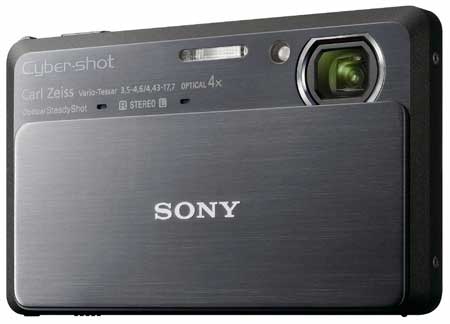Sony Cyber-shot DSC-TX9
-
-
Written by Gordon Laing
Verdict
The Sony Cyber-shot DSC-TX9 is an update to the popular Cyber-shot TX7. It features the same 25-100mm stabilised optical zoom lens and 3.5 inch LCD touch-screen. The TX9 also retains Sony’s ‘Exmor R’ back-illuminated CMOS technology on the sensor, but adds an extra 2 Megapixels to bring the resolution up to 12.2 Megapixels.
Other new features exploit the Exmor R sensor’s fast continuous shooting capabilites (a 10 frame burst at up to 10fps), providing composite modes designed to increase image quality and there are also some new 3D panoramic shooting options. The Cyber-shot TX9 is also a very capable video camera, providing full HD recording at 1080i resolution.
 |
Compared to Nikon COOLPIX S80
At least as far as their appearance goes, the Nikon COOLPIX S80 and Sony Cyber-shot TX9 are very similar cameras. If imitation is the sincerest form of flattery then Sony should be flattered by the fact that the COOLPIX shares almost the exact same dimensions (it’s actually a millimetre thinner) and adopts a similar sliding cover mechanism, though on the COOLPIX S80 it travels horizontally rather that vertically.
Once you get beyond appearances some key differences emerge. First the COOLPIX has a 5X optical zoom, but with a range that starts at 35mm equivalent it lacks the Cyber-shot TX9’s super-wide-angle coverage. We think that’s a lot more useful than the S80’s 175mm telephoto, but your view may differ. The COOLPIX S80 also has 2 more Megapixels on its CCD sensor but again it’s a case of more not necessarily being better. Yes, you’ll be able to make bigger prints, but we think the Cyber-shot TX9 has the edge when it comes to overall image quality.
One other area in which the Cybershot TX9 has a clear advantage is video, with 1080i full HD at two quality settings and AVCHD and MP4 encoding compared to the COOLPIX S80’s 720p top quality video mode.
On a touch-screen camera the screen is obviously an important factor. Both models have a 3.5 inch screen with similar resolution and although they use different display technologies there’s actually very little to tell them apart in terms of viewing quality. We prefer the layout of the Sony touch icons and menus and found the Sony’s tactile feedback, or haptics to use the jargon, provided a smoother more natural experience. This is, of course, a very subjective area and we’d recommend you get to try out these touch screen models before buying.
With these two cameras very closely matched in terms of price you’re going to have to decide which of these features matter most to you, but with excellent wide angle coverage, Full HD video and awesome burst shoting modes, the TX9 is looking like a tough one to beat. For more details, see our Nikon COOLPIX S80 review.
Compared to Panasonic Lumix DMC-FX700
Unlike the COOLPIX S80 the Panasonic Lumix FX700 doesn’t bear even a passing resemblance to Sony’s Cyber-shot TX9. With a more conventional compact body styling it’s significanly bigger and heavier and, though it’s a handsome-looking camera, it lacks the TX9’s style.
So what about the substance? with a 5x optical zoom the FX700 outguns the TX9 but, crucially, it manages to do this at both ends of the focal range with a 24mm super-wide angle and 120mm equivalent at the telephoto end of the range. The 1mm advantage in wide angle view won’t make a lot of difference, but that extra reach at the telephoto end can’t be ignored
The Lumix FZ700 matches the Cyber-Shot TX9 for video perfomance with 1080i AVCHD recording and a zoom that can be used during recording. Like the TX9 it has a CMOS sensor which equips it with some fast continuous shooting modes.
At 3 inches, The FX700’s screen is a little smaller than the TX9’s and lacks it’s high resolution. While you can live with the slightly less sparkling viewing performace this entails, it’s more significant when it comes to touch-screen use and we found the smaller screen and the proliferation of icons made for inferior usability. As we’ve said before though, this is a subjective view and you really need to get your hands on these cameras before buying. When you get to that point the Lumix FX700’s significantly lower price tag may well influence your decision.
For more details, see our Panasonic Lumix DMC-FX700 review.
Also consider: Canon IXUS 210 / PowerShot SD3500 IS
– see our Canon IXUS 210 / SD3500 IS review.
Sony Cyber-shot DSC-TX9 verdict
The Sony Cyber-shot TX9 is an interesting move by Sony. Possibly worried that it’s 10 Megapixel TX7 was losing ground to cameras like Canon’s 14.1 Megapixel IXUS 210 / SD3500 IS and newcomers like the COOLPIX S80 and Lumix FX700, also with 14 Megapixel sensors, it has updated the TX7 with a higher resolution sensor. There are other improvements; superior Auto mode will be a draw for point-and-shoot users and the 3D panorama modes will be a draw for those who own 3D TVs, but current TX7 owners won’t be feeling a burning need to trade up.
That doesn’t of course change the fact that this is a great little camera with some fantastic features including a capable 4x zoom, good low light performance, top-notch video recording modes, outstanding fast continuous shooting modes and a great touch-screen experience all in a very compact and extremely stylish package.
In what’s quickly becoming a very competitive sector of the compact market the Cyber-shot TX9 deserves to and will undoubtedly do very well. However, if you can resist the lure of high Megapixel resolutions and aren’t straining at the leash to experience 3D panoramas, the earlier Cyber-shot TX7 remains a very compelling alternative.
Bad points | Scores (relative to 2010 compacts) |
 | ||
Build quality: Image quality: Handling: Specification: Value:
Overall: |
18 / 20 16 / 20 15 / 20 18 / 20 17 / 20
84% | |||






